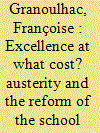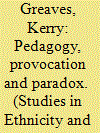| Srl | Item |
| 1 |
ID:
107207


|
|
|
|
|
| Publication |
2011.
|
| Summary/Abstract |
This article considers possible future directions for education policy and public service governance under the Conservative-led coalition government. The article considers the extent to which Conservatives might develop a distinctive strategy for managing public services that breaks decisively with that of the New Labour era. The coalition faces a markedly different political and economic context for public service reform compared to its predecessor. This article argues that these contextual constraints make a continuation of the New Labour governing strategy less viable, but unresolved tensions in the coalition education policies enacted to date may hinder the development of a novel project for education reform. As a consequence, the New Labour education project seems likely to remain largely intact for the foreseeable future.
|
|
|
|
|
|
|
|
|
|
|
|
|
|
|
|
| 2 |
ID:
155415


|
|
|
|
|
| Summary/Abstract |
The reform of the school system, which has been conducted by the Coalition and Conservative governments since 2010, has largely been austerity-driven. In spite of the governments’ pledge to protect their budgets, schools have been severely hit by spending cuts. The reform programme has itself been integral to the fiscal consolidation plans by promoting a more cost-effective system of state schooling. This article discusses the relationship between austerity and reform, and looks at the consequences for the concept of public service. Some specific aspects of the new institutional framework are examined, especially the creation of an independent state sector made up of academies and free schools, which has entrenched the involvement of private sector firms in education. The overhaul of the school system, which started nearly thirty years ago, has now reached a new decisive stage. However, considering the complex relationship between multiple actors and the opposing forces at work, one cannot say with any certainty that it will cause the demise of public service state education.
|
|
|
|
|
|
|
|
|
|
|
|
|
|
|
|
| 3 |
ID:
127029


|
|
|
|
|
| Publication |
2013.
|
| Summary/Abstract |
The last two decades of the nineteenth century witnessed an apparent revolution in art education in Denmark with the establishment of the 'Free Schools', a group of alternative schools that provided students with a choice other than the Royal Academy. The most important of these schools, the Kunstnernes Studieskole (Artists' Study School, established in 1882), was subsidised by the government and headed by Laurits Tuxen, P.S. Krøyer, and Kristian Zahrtmann, Academy-trained artists who modeled the school's education on the French atelier system. The debate that formed the Study School was at its core one of democratization, which was perceived to be synonymous with international modernism. Yet its artists functioned within a network of fluid roles designed to openly augment the existing pedagogical structure from within - a specifically Danish phenomenon. This article proposes an alternative framework for late-nineteenth-century Danish art education systems that situates the Study School within the context of Danish culture and as an extension of the social democratic tendencies proliferating at this time, which were significantly influenced by the preacher N.F.S. Grundtvig. Danish artists' actual situation had more to do with assimilating a myriad of local and international impulses into a specifically Danish version of modernism.
|
|
|
|
|
|
|
|
|
|
|
|
|
|
|
|